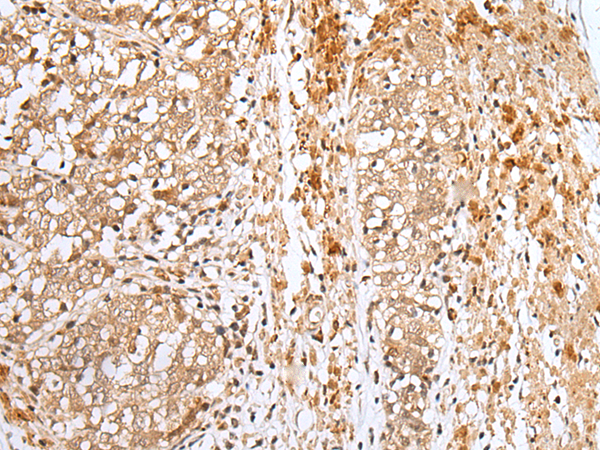
| WB | 咨询技术 | Human,Mouse,Rat |
| IF | 咨询技术 | Human,Mouse,Rat |
| IHC | 1/25-1/100 | Human,Mouse,Rat |
| ICC | 技术咨询 | Human,Mouse,Rat |
| FCM | 咨询技术 | Human,Mouse,Rat |
| Elisa | 1/5000-1/10000 | Human,Mouse,Rat |
| Aliases | CNF; NPHN; nephrin |
| Host/Isotype | Rabbit IgG |
| Antibody Type | Primary antibody |
| Storage | Store at 4°C short term. Aliquot and store at -20°C long term. Avoid freeze/thaw cycles. |
| Species Reactivity | Human |
| Immunogen | Synthetic peptide of human NPHS1 |
| Formulation | Purified antibody in PBS with 0.05% sodium azide and 50% glycerol. |
+ +
以下是关于NPHS1抗体的3篇经典参考文献及其摘要:
1. **《Nephrin is specifically located at the slit diaphragm of glomerular podocytes》**
- **作者**: Patrakka, J., et al.
- **摘要**: 该研究通过免疫组化和电子显微镜技术证实,NPHS1基因编码的nephrin蛋白特异性地表达于肾小球足细胞的裂孔隔膜上,是维持肾滤过屏障完整性的关键分子,其缺陷可导致先天性肾病综合征。
2. **《Positionally cloned gene for a novel glomerular protein—nephrin—is mutated in congenital nephrotic syndrome》**
- **作者**: Kestilä, M., et al.
- **摘要**: 本研究首次克隆了NPHS1基因,并发现其突变导致芬兰型先天性肾病综合征。通过抗体检测发现患者肾组织中nephrin表达显著缺失,揭示了其在疾病发生中的核心作用。
3. **《The role of nephrin in the glomerular filtration barrier and proteinuria》**
- **作者**: Tryggvason, K., et al.
- **摘要**: 综述了nephrin在肾小球滤过屏障中的分子机制,强调NPHS1抗体在检测足细胞损伤及蛋白尿病理模型中的应用,为肾病诊断和靶向治疗提供了理论依据。
这些文献涵盖了NPHS1抗体的关键研究,包括基因定位、疾病关联及功能机制。如需具体实验细节或近年研究,建议通过PubMed或Google Scholar检索最新论文。
NPHS1 antibodies target nephrin, a critical transmembrane protein encoded by the *NPHS1* gene, primarily expressed in podocytes of the kidney glomerulus. Nephrin plays a pivotal role in maintaining the integrity of the glomerular filtration barrier by forming the slit diaphragm, a specialized cell-cell junction regulating selective permeability. Mutations in *NPHS1* are linked to congenital nephrotic syndrome of the Finnish type (CNF), a severe autosomal recessive disorder characterized by massive proteinuria and renal failure in infancy.
NPHS1 antibodies are widely used in research and diagnostics to study nephrin expression, localization, and function. In research, these antibodies help elucidate molecular mechanisms underlying podocyte injury, proteinuria, and glomerular diseases like focal segmental glomerulosclerosis (FSGS). Clinically, they aid in diagnosing CNF through immunohistochemical staining of renal biopsies, revealing absent or reduced nephrin in affected individuals.
Additionally, NPHS1 antibodies are employed in experimental models (e.g., knockout mice) to explore therapeutic strategies targeting podocyte repair. Their utility extends to investigating acquired kidney diseases where nephrin downregulation or mislocalization occurs due to secondary insults (e.g., diabetes, immune-mediated injury). Understanding nephrin biology via NPHS1 antibodies remains vital for advancing podocyte-targeted therapies and precision nephrology.
×